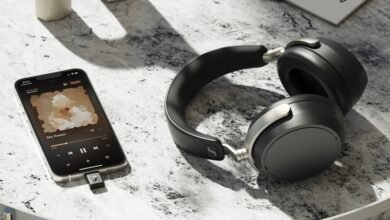Google Pixel Buds 2a Review: The Perfect Budget Headphones

▼ Summary
– The Pixel Buds 2a feature a smaller, more comfortable design with ANC and spatial audio, but are $30 more expensive than their predecessors.
– The earbuds have reliable battery life of about 7 hours with ANC, but the compact case only provides 20 hours of reserve power and lacks wireless charging.
– Touch controls are flawed, lacking physical volume adjustment and often misinterpreting taps, making them unreliable for daily use.
– Sound quality is good but not great, with balanced audio that can sound slightly muffled, and ANC effectively blocks white noise but struggles with organic sounds.
– Despite some shortcomings, the Pixel Buds 2a are a solid all-around option, especially if purchased on sale, due to their comfort and integration with Android.
Finding the perfect balance between affordability and performance in wireless earbuds is a challenge many shoppers face. After a four-year break from budget-friendly models, Google has re-entered the arena with the Pixel Buds 2a. These earbuds arrive with a refreshed, more compact design, active noise cancellation, and spatial audio support. However, the market has evolved significantly since 2021, and with a higher price tag than their predecessors, the Buds 2a face stiff competition, making their value proposition less straightforward than one might hope.
The Pixel Buds 2a feature a noticeable makeover. Both the earbuds and their charging case are smaller than previous models. The case retains Google’s signature rounded, pebble-like shape, but its reduced dimensions make it exceptionally pocketable. This level of portability turns them into “why not” earbuds, easy to grab on your way out without a second thought. A matte finish covers most of the case, providing a secure grip and resisting fingerprints, while the interior uses glossy plastic. A welcome hardware feature is the replaceable battery hidden within the case, a design choice that could extend its usable life for years, though the earbuds themselves do not share this benefit.
Comfort sees a major improvement. The new earbuds are significantly smaller and lack stems, fitting snugly in the ear. The redesigned wing tip is more effective at keeping them secure, even during physical activity, and the insert-and-twist method recommended by Google works well. While comfort is subjective, the combination of a minimal wing tip and four included ear tip sizes should accommodate most users comfortably for extended periods.
The touch controls, however, remain a notable weakness. For the second generation, Google has reserved physical volume controls for its more expensive models. On the Buds 2a, you can tap to play, pause, or skip tracks, and press and hold to toggle noise cancellation or activate Gemini. Adjusting the volume, however, requires using your phone’s buttons or issuing a voice command, which feels outdated. Beyond this limitation, the touch controls themselves are often unreliable. Inputs are frequently missed or misinterpreted, leading to accidental activation of the wrong mode. This inconsistency can be a genuine frustration in daily use.
On the software front, the integration with Pixel phones is nearly seamless. After a quick initial setup, the earbuds connect instantly when removed from the case. All settings are managed directly within the Android settings menu, eliminating the need for a separate app. The interface is clean and intuitive, making it simple to check battery levels, switch between sound modes, or adjust the equalizer. Key features like multipoint connectivity, which allows pairing with two devices simultaneously, are available but must be manually enabled in the settings. It’s also crucial to register the earbuds with Google’s Find My Device service during setup for easy recovery if they are lost.
Battery performance is a mixed bag. The earbuds themselves are impressive, easily meeting Google’s claim of around seven hours of playback with ANC active. The case, however, only provides about 20 hours of additional charge. For frequent users, this means needing to recharge the case every few days, a cycle that is less convenient without the inclusion of wireless charging.
When it comes to audio quality, “good, not great” is an accurate summary. The sound profile is enjoyable and well-balanced, with clear bass that doesn’t overpower other frequencies. However, the overall presentation can sometimes feel slightly muffled, lacking the crystal-clear detail and immersive soundstage found in more premium headphones. You get a perfectly pleasant listening experience, but not a transformative one.
The active noise cancellation (ANC) is effective for constant, low-frequency sounds like air conditioners or fans, reducing them to a near-silent hum. It struggles, however, with more irregular or organic noises, such as television dialogue or keyboard clicks, which remain audible though muted. The passthrough, or transparency, mode is a weaker point. It often fails to balance audio levels correctly, sometimes amplifying background noise to the point where it drowns out a conversation partner’s voice. For phone calls, the microphone quality is serviceable. Callers reported that my voice was clear, though not as pristine as when using the phone directly, and some background noises like typing were still perceptible.
The market is crowded with compelling alternatives, from Nothing’s distinctive earbuds to the frequently discounted OnePlus Buds Pro 3, which often outperform the Pixel Buds 2a in specific areas like sound or ANC. Despite its shortcomings, the Pixel Buds 2a is a competent all-rounder. Its strengths in comfort, seamless software integration, and solid core performance make it a likable package. The most prudent advice for potential buyers might be to exercise a little patience; at their full $130 price, they are a decent option, but if they drop to $99 or less, their value becomes significantly more compelling.
(Source: 9to5 Google)




